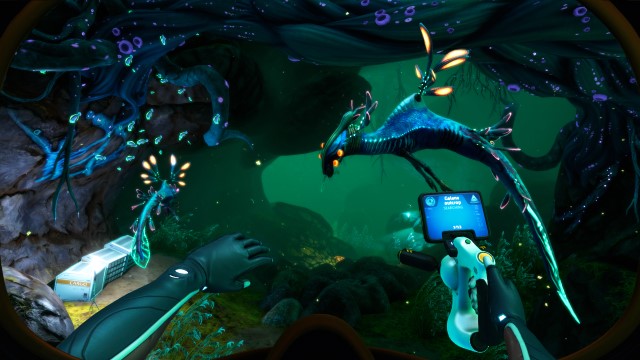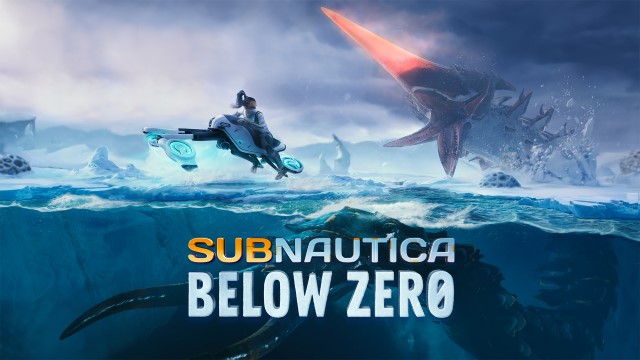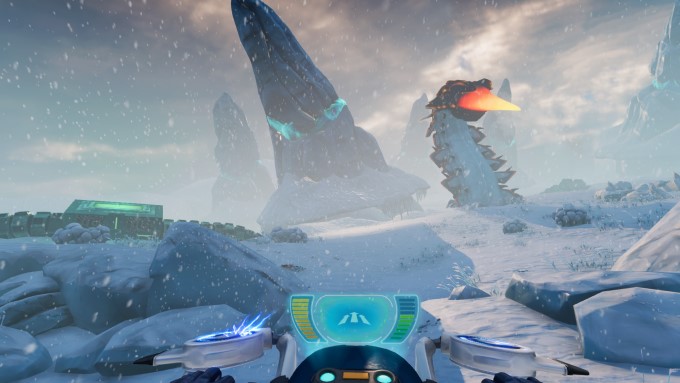Strictly speaking, it’s not necessary to play the original Subnautica before diving into its sequel, Below Zero, but we highly recommend you do so anyway. This continuation of the first game takes you on a new adventure across the mysterious ocean world of Planet 4546B, where you’ll dive into the planet’s polar extremes.
Subnautica, as a series, is a mix of survival and crafting-style gaming, with a hefty dash of exploration thrown in. And it presents one of the most consistently beautiful and impressive gaming worlds out there.
Subnautica Below Zero Review: A Gorgeous Trek into Unknown Waters
Below Zero features a new protagonist and storyline, but the gameplay mechanics are largely identical to the first game. Here, our stalwart explorer is desperately looking into the death of her sister, who was stationed on the strange ocean world. Unfortunately, your entrance to 4546B is via yet another crashed escape pod, meaning you’re starting with almost nothing to aid in your search or survival.
Luckily, the pod has a handy 3D printer for making tools, supplies, and ingredients, and the planet is a treasure trove of natural resources the printer can use. Gathering those resources is really the main focus of Subnautica. Cracking rocks, cutting creepvines, going ever deeper to get more supplies and vehicle parts, and even catching fish and other creatures are all vital in staying alive.
Your handy scanner is the most important tool for learning what’s what. Scanning everything you come across not only fills in the game’s massive database but also adds new crafting recipes. Scanning pieces of scattered debris from the crash leads to more advanced tech, such as vehicles that let you explore Below Zero‘s even deeper depths.
Subnautica and Below Zero work so well and feel so distinctive for a few key reasons. The first is that it places upon you natural limits to pace exploration. You have to breathe to survive and for a fair portion of the game, straying too far from the surface means certain death. There are bigger O2 tanks to craft and even natural phenomena in the water that can provide a brief air burst, but there’s always a sense of paranoia about going too deep.
It’s a problem to overcome since you’ll want (and frequently need) to explore the world as thoroughly as possible. There’s a surprising Metroidvania vibe here, where new discoveries enable you to craft new tech that lets you reach new areas. Instead of Metroid’s glowing orbs trapped in ancient statues and guarded by mini-bosses, much of the progression here is found just by scanning, gathering resources, and exploring.
Indeed, combat here is almost non-existent. You have access to a precious few weapon-like items (the survival knife chief among them). But Subnautica isn’t a game about killing things, aside from smaller fish for food and resources. In general, the wildlife — even the massive leviathans — are just part of the overall environment. You work around them and appreciate them, avoiding the dangerous ones and enjoying the adorable ones.
Also, there are alien penguins called penglings and, despite the odd mouth placement, they’re absurdly cute. Unless you try to steal the babies. Don’t steal babies. It’s just rude.
Aside from definitely not stealing cute babies, base building is a huge part of Subnautica‘s appeal. Scanning abandoned equipment, tech, and bases yields more crafting options. Once you’ve got a base-building tool, the options for undersea habitats are nearly limitless. You can even build on the land and the sheer plethora of customization choices for building your own environment is impressive.
Subnautica Below Zero continues the first game’s friendly array of game options. You can play in full-on survival mode where thirst, hunger, and oxygen are all significant issues. Freedom mode lets you ditch food and water worries, but you still have to surface for oxygen. Finally, for people who just want to explore and build, creative mode ditches the story and lets you go crazy making whatever you like. It’s also a great way of seeing all the sights without the fear of death.
Below Zero plays out entirely in first-person and can go from a wondrous zen-like experience to flat-out tension-filled terror in no time flat. Not focusing on combat adds to every aspect of the game without ever feeling forced. The diversity of fascinating biozones helps navigation, and there’s a much stronger land presence here than in the original Subnautica. While Below Zero is still largely underwater, the arctic zone has definite landmasses that need to be investigated with their own set of unique fauna and flora.
Subnautica’s alien world is simply stunning. The aquatic biomes are full of beautiful creatures and scenery, a myriad of caves and secrets to explore, and superb lighting. The visual fidelity of the game makes the gameplay addictive and compelling. The overall soundtrack is equally as impressive. Aside from a beautiful, evocative musical score, the ambient effects and creature noises are phenomenal.
On the PC side, the game has been in Early Access for over two years. It’s finally officially released and on consoles. Having played it across PC, Xbox Series X, and Switch, we have no qualms saying the game is great on whichever platform you choose. While the PC and XSX/PS5 versions are definitely the most impressive ways to experience the game, we were surprisingly impressed by how good the Switch port is.
Both the original and Below Zero look and play exceedingly well on the Switch Lite (and regular Switch in portable mode). In docked TV mode, the resolution drop is noticeable, but the overall experience is still smooth and visually impressive. The portable version is so good that we wish there was a cross-save option so players could take their saves from the Xbox/PS5 or PC to the Switch and play the same game anywhere (much like Ubisoft has done with Immortals: Fenyx Rising).
Some issues from the first game are still in Below Zero. The biggest problem is the mind-boggling lack of a usable world map. Why this issue still persists in either game is a mystery, but it’s incredibly annoying. The game is still a bit buggy, too. It’s possible to get stuck in the architecture, base building alignment and placement is a little messy at times, and the sweet spot to interact with objects while floating can be annoyingly precise.
For things like floating storage boxes, for instance, there are three interaction spots (one for naming it, another for packing it up, and a third for actually accessing the contents), and given the nature of swimming, it can be troublesome to quickly access the contents. All objects tend to require finesse to interact with, which can be an extra source of frustration if you’re in a hurry or under duress.
Subnautica Below Zero Review — The Bottom Line

Pros
- Looks and sounds great
- Excellent story
- Deep crafting and base building
- Multiple game modes to accommodate a variety of players
Cons
- Still glitchy in spots
- Interaction sweet spot for objects can be annoyingly finicky
- No map
- Needs cross-platform saves
Subnautica Below Zero works great as both a fascinating aquatic survival and crafting game, and an engaging sci-fi adventure. While it’s not quite as impressive as the original, which it takes heavily from, this is still a sizable journey well worth a deep dive.
[Note: Unknown Worlds provided the copy of Subnautica: Below Zero used for this review.]








Published: May 10, 2021 01:45 pm